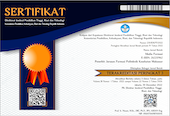Pengaruh Pemberian Alpha Lipoic Acid Terhadap Perubahan Histopatologi Tikus Putih Yang Diinduksi Diet Tinggi Lemak
Abstract
Liver is one of the most vital organs that functions as a center for metabolism. One of the diseases that disrupt liver function with a high prevalence is NAFLD (Non Alcoholic Fatty Liver Disease). NAFLD is characterized by increased intracellular triglyceride accumulation. Increased lipid peroxidation can lead to Non Alcoholic Steato Hepatitis (NASH) and cirrhosis which induces proinflammatory cytokines. Alpha lipoic acid (ALA) is an antioxidant that has been widely used in treating metabolic syndrome. Based on several previous studies. ALA may be useful for the treatment of NAFLD by targeting various pathways in the development of NAFLD. The study divided animals into five groups as standard feed; high fat diet (HFD); HFD and ALA 100 mg/kg BW i.p .; HFD and ALA 100 mg/kg BW i.p also repaired - fed; HFD and repaired – fed. Based on the results of the study, it can be concluded that ALA as an antioxidant can improve liver cell histopathology in NAFLD rat induced high fat diet.
Keywords : non alcoholic fatty liver disease, NAFLD, alpha lipoic acid, high fat diet
Hati adalah salah satu organ paling vital yang berfungsi sebagai pusat metabolisme. Salah satu penyakit yang mengganggu fungsi hati dengan prevalensi tinggi adalah PHNA (Perlemakan Hati Non Alkohol). PHNA ditandai dengan peningkatan akumulasi trigliserida intraseluler. Peroksidasi lipid yang meningkat dapat menuju Non Alcoholic Steato Hepatitis (NASH). Alpha lipoic acid (ALA) merupakan antioksidan yang telah banyak digunakan dalam mengobati sindroma metabolik. Berdasarkan beberapa studi sebelumnya. ALA mungkin berguna untuk pengobatan PHNA dengan menargetkan berbagai jalur dalam perkembangan PHNA. Penelitian ini dilakukan dengan membagi hewan uji menjadi lima kelompok dengan kontrol negatif dengan pemberian pakan standar; kontrol positif dengan pemberian high fat diet (HFD); kelompok perlakuan pertama dengan pemberian HFD dan ALA 100 mg/kg BB i.p.; kelompok perlakuan kedua dengan pemberian HFD dan ALA 100 mg/kg BB i.p juga dilakukan repair – fed; kelompok perlakuan ketiga dengan pemberian HFD dan kemudian dilakukan repair – fed. Berdasarkan hasil penelitian, dapat disimpulkan bahwa ALA sebagai antioksidan dapat memperbaiki histopatologi sel hati terhadap NAFLD pada tikus yang diberi diet high fat diet (HFD).
Kata kunci : perlemakan hati non alkohol, PHNA, NAFLD, αlpha lipoic acid, diet tinggi lemak
Full Text:
PDF (Bahasa Indonesia)References
Allen, E. S. 2002 The Liver : Anatomy , Physiology , Disease and Treatment, Human Anatomy & Physiology, pp. 3–11.
Almeda-Valdés, P., Cuevas-Ramos, D. and Aguilar-Salinas, C. A. 2009 Metabolic syndrome and non-alcoholic fatty liver disease., Annals of Hepatology, 8(Suppl 1), pp. S18–S24.
Atmaca, G. 2004 Antioxidant effects of sulfur-containing amino acids, Yonsei Medical Journal, pp. 776–788. doi: 200410776 [pii].
Dyson, J. K., Anstee, Q. M. and McPherson, S. 2015) Republished: Non-alcoholic fatty liver disease: a practical approach to treatment, Postgraduate Medical Journal, 91(1072), pp. 92–101. doi: 10.1136/postgradmedj-2013-100404rep.
Ferramosca, A., Di Giacomo, M. and Zara, V. 2017 Antioxidant dietary approach in treatment of fatty liver: New insights and updates, World Journal of Gastroenterology, 23(23), pp. 4146–4157. doi: 10.3748/wjg.v23.i23.4146.
Jung, T. S. et al. 2012 a -lipoic acid prevents non-alcoholic fatty liver disease in OLETF rats, (11), pp. 1–9. doi: 10.1111/j.1478-3231.2012.02857.x.
Liang, W. et al. 2014 Establishment of a General NAFLD Scoring System for Rodent Models and Comparison to Human Liver Pathology, PLoS ONE, pp. 1–17. doi: 10.1371/journal.pone.0115922.
Ozougwu, J. C. and Eyo, J. E. 2014 Hepatoprotective effects of Allium cepa (onion) extracts against paracetamol-induced liver damage in rats, African Journal of Biotechnology, 13(26), pp. 2679–2688. doi: 10.5897/AJB2014.13815.
Petta, S., Muratore, C. and Craxì, A. 2009 Non-alcoholic fatty liver disease pathogenesis: The present and the future, Digestive and Liver Disease, 41(9), pp. 615–625. doi: 10.1016/j.dld.2009.01.004.
Prasanna K. Santhekadur, D. P. K. and A. J. S. 2019 Preclinical Models of Nonalcoholic Fatty Liver Disease, Journal of Hepatology, 68(2), pp. 230–237. doi: 10.1016/j.jhep.2017.10.031.PRECLINICAL.
Rector, R. S. et al. 2008 Non-alcoholic fatty liver disease and the metabolic syndrome: an update., World journal of gastroenterology : WJG, 14(2), pp. 185–192. doi: 10.3748/wjg.14.185.
Schwenger, K. J. P. and Allard, J. P. 2014 Clinical approaches to non-alcoholic fatty liver disease, World Journal of Gastroenterology, 20(7), pp. 1712–1723. doi: 10.3748/wjg.v20.i7.1712.
Tonukari, N. J. 2012 African Journal of, 11(2), pp. 133–140.
Valdecantos, M. P. et al. 2012 Lipoic acid administration prevents nonalcoholic steatosis linked to long-term high-fat feeding by modulating mitochondrial function, Journal of Nutritional Biochemistry, 23(12), pp. 1676–1684. doi: 10.1016/j.jnutbio.2011.11.011.
DOI: https://doi.org/10.32382/mf.v17i2.2340
Refbacks
- There are currently no refbacks.

This work is licensed under a Creative Commons Attribution-NonCommercial-ShareAlike 4.0 International License.
Kontak Editor
Hendra Stevani
Jurusan Farmasi Poltekkes kemenkes Makassar
email : hendra@poltekkes-mks.ac.id

This work is licensed under a Creative Commons Attribution-ShareAlike 4.0 International License.




.png)


